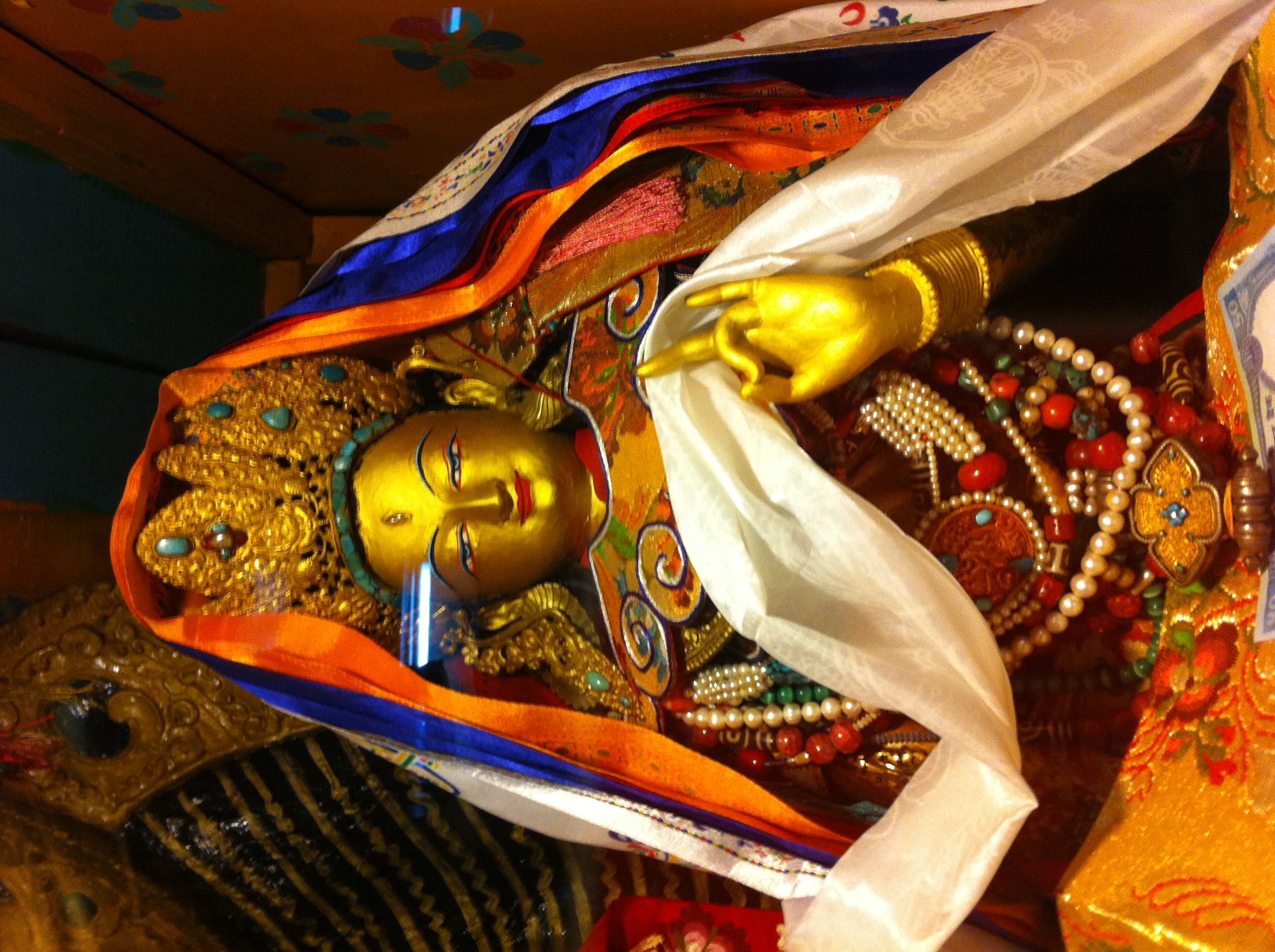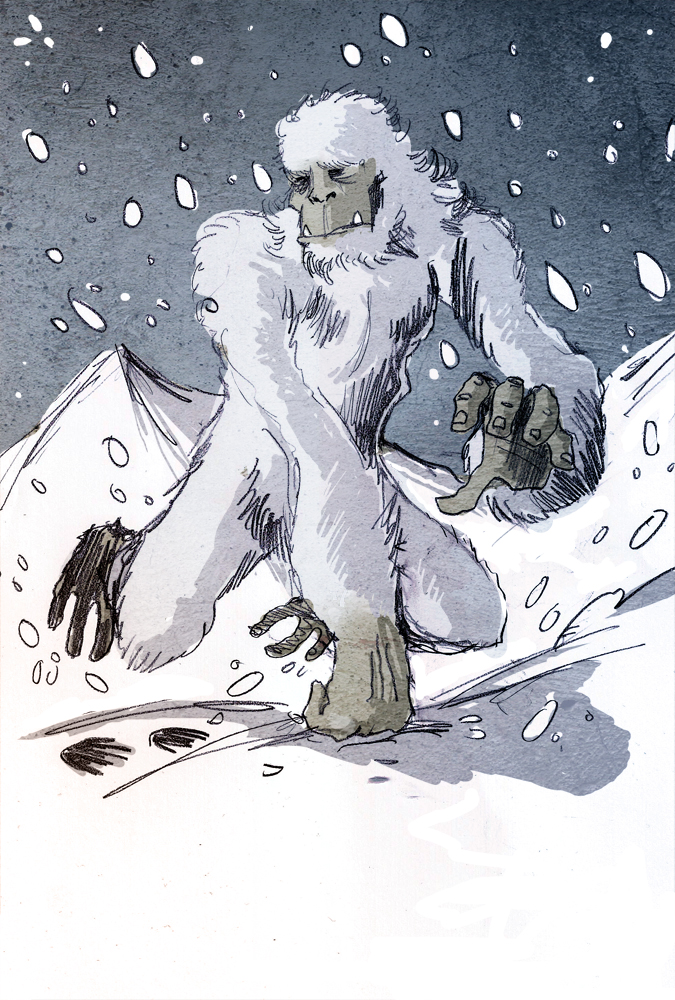|
Tibetan Mythology
Tibetan mythology refers to the traditional as well as the religious stories that have been passed down by the Tibetan people. Tibetan mythology consists mainly of national mythology stemming from the Tibetan culture as well as religious mythology from both Tibetan Buddhism and Bön Religion. These myths are often passed down orally, through rituals or through traditional art like sculptures or cave paintings. They also feature a variety of different creatures ranging from gods to spirits to monsters play a significant role in Tibetan mythology with some of these myths have broken into mainstream Western media, with the most notable one being the Abominable Snowman – the Yeti. National mythology National Tibetan mythology stems from the history of the country, and was passed down by word of mouth or works of art such as cave paintings. The latter include gods and sacred mythological creatures like the Five Clawed Great Eagle of the Sky, and also record information about how the ... [...More Info...] [...Related Items...] OR: [Wikipedia] [Google] [Baidu] |
Jokhang Temple In Tibet
The Jokhang (, ), also known as the Qoikang Monastery, Jokang, Jokhang Temple, Jokhang Monastery and Zuglagkang ( or Tsuklakang), is a Buddhist temple in Barkhor Square in Lhasa, the capital city of Tibet Autonomous Region of China. Tibetans, in general, consider this temple as the most sacred and important temple in Tibet. The temple is currently maintained by the Gelug school, but they accept worshipers from all sects of Buddhism. The temple's architectural style is a mixture of Indian vihara design, Tibetan and Nepalese design. The Jokhang was founded during King Songtsen Gampo's reign of the Tibetan Empire. According to tradition, the temple was built for the king's two brides: Princess Wencheng of the Chinese Tang dynasty and Princess Bhrikuti of Nepal. Both are said to have brought important Buddhist statues and images from China and Nepal to Tibet, which were housed here, as part of their dowries. The oldest part of the temple was built in 652. Over the next 900 years, th ... [...More Info...] [...Related Items...] OR: [Wikipedia] [Google] [Baidu] |
Tara (Buddhism)
Tara ( sa, तारा, ; bo, སྒྲོལ་མ, ), Ārya Tārā, or Shayama Tara, also known as Jetsun Dölma (Tibetan: ''rje btsun sgrol ma'') is an important figure in Buddhism, especially revered in Tibetan Buddhism. She appears as a female bodhisattva in Mahayana Buddhism, and as a female Buddha in Vajrayana Buddhism. She is known as the "mother of liberation", and represents the virtues of success in work and achievements. She is known as ''Duōluó Púsà'' (多羅菩薩) in Chinese Buddhism, and as ''Tara Bosatsu'' (多羅菩薩) in Japan. Tārā is a meditation deity revered by practitioners of the Tibetan branch of Vajrayana Buddhism to develop certain inner qualities and to understand outer, inner and secret teachings such as karuṇā (compassion), mettā (loving-kindness), and shunyata (emptiness). Tārā may more properly be understood as different aspects of the same quality, as bodhisattvas are often considered personifications of Buddhist methods. Ther ... [...More Info...] [...Related Items...] OR: [Wikipedia] [Google] [Baidu] |
Turkic Mythology
Turkic mythology refers to myths and legends told by the Turkic people. It features Tengrist and Shamanist strata of belief along with many other social and cultural constructs related to the nomadic and warrior way of life of Turkic and Mongol peoples in ancient times. Turkic mythology shares numerous points in common with Mongol mythology. Turkic mythology has also been influenced by other local Asiatic and Eurasian mythologies. For example, in Tatar mythology elements of Finnic and Indo-European mythologies co-exist. Beings from Tatar mythology include Äbädä, Alara, Şüräle, Şekä, Pitsen, Tulpar, and Zilant. The ancient Turks apparently practised all the then-current major religions in Inner Asia, such as Tibetan Buddhism, Nestorian Christianity, Judaism, and Manichaeism, before the majority's conversion to Islam filtered through the mediation of Persian and Central Asian culture, as well as through the preaching of Sufi Muslim wandering ascetics and mystics ( fakirs ... [...More Info...] [...Related Items...] OR: [Wikipedia] [Google] [Baidu] |
Wind Horse
The wind horse is a symbol of the human soul in the shamanistic tradition of East Asia and Central Asia. In Tibetan Buddhism, it was included as the pivotal element in the center of the four animals symbolizing the cardinal directions and a symbol of the idea of well-being or good fortune. It has also given the name to a type of prayer flag that has the five animals printed on it. Depending on the language, the symbol has slightly different names. * , pronounced ''lungta'', Tibetan for "wind horse" * mn, хийморь, Khiimori, literally "gas horse," semantically "wind horse," colloquial meaning ''soul''. In Tibetan usage In Tibet, a distinction was made between Buddhism (, literally "divine dharma") and folk religion (, "human dharma"). Windhorse was predominantly a feature of the folk culture, a "mundane notion of the layman rather than a Buddhist religious ideal," as Tibetan scholar Samten G. Karmay explains.Karmay, Samten G. ''The Arrow and the Spindle: Studies in His ... [...More Info...] [...Related Items...] OR: [Wikipedia] [Google] [Baidu] |
Smallfoot (2018 Film)
''Smallfoot'' (stylized as ''SMALL FOOT'') is a 2018 American computer-animated musical comedy film produced by the Warner Animation Group and distributed by Warner Bros. Pictures. Based on the unpublished children's book ''Yeti Tracks'' by Sergio Pablos, the film was co-written and directed by Karey Kirkpatrick, and stars the voices of Channing Tatum, James Corden, Zendaya, Common, LeBron James, Gina Rodriguez, Danny DeVito, Yara Shahidi, Ely Henry, and Jimmy Tatro. The plot follows a tribe of Himalayan Yeti who come across a human being, with each species thinking the other was just a myth. ''Smallfoot'' was theatrically released in the United States on September 28, 2018. It received a mostly positive reception from critics and grossed over $214 million at the box office. Plot A village of Yetis live in isolation on the top of a mountain in the Himalayas, above the clouds and hidden away from sight. Migo is a yeti who abides by the law of the ancient stones held by the Stonek ... [...More Info...] [...Related Items...] OR: [Wikipedia] [Google] [Baidu] |
Abominable (2019 Film)
''Abominable'' is a 2019 computer-animated adventure film produced by DreamWorks Animation and Pearl Studio, written and directed by Jill Culton and co-directed by Todd Wilderman, and stars the voices of Chloe Bennet, Albert Tsai, Tenzing Norgay Trainor, Eddie Izzard, Sarah Paulson, Tsai Chin, and Michelle Wong. The film follows a teenage girl named Yi, who encounters a young Yeti on the roof of her apartment building in Shanghai, names him Everest and embarks on an epic quest to reunite the magical creature with his family at the highest point on Earth along with her mischievous friends Jin and Peng, but the trio of friends will have to stay one-step ahead of Burnish, a wealthy man intent on capturing a Yeti, and zoologist Dr. Zara to help Everest get home. The film premiered at the Toronto International Film Festival on September 7, 2019, and was released by Universal Pictures in the United States on September 27 while Pearl Studio distributed the film in China. The film rec ... [...More Info...] [...Related Items...] OR: [Wikipedia] [Google] [Baidu] |
Yeti
The Yeti ()"Yeti" ''Random House Webster's Unabridged Dictionary''. is an ape-like creature purported to inhabit the Himalayan mountain range in Asia. In western popular culture, the creature is commonly referred to as the Abominable Snowman. Many dubious articles have been offered in an attempt to prove the existence of the Yeti, including Anecdotal evidence, anecdotal visual sightings, disputed video recordings, photographs, and plaster casts of large footprints. Some of these are speculated or known to be hoaxes. Folklore studies, Folklorists trace the origin of the Yeti to a combination of factors including Sherpa people, Sherpa folklore and misidentified fauna such as Himalayan brown bear, bear or yak. The Yeti is commonly compared to Bigfoot of North America, as the two subjects often have similar physical descriptions. ...
|
Manjushri
Mañjuśrī (Sanskrit: मञ्जुश्री) is a ''bodhisattva'' associated with '' prajñā'' (wisdom) in Mahāyāna Buddhism. His name means "Gentle Glory" in Sanskrit. Mañjuśrī is also known by the fuller name of Mañjuśrīkumārabhūta (),Keown, Damien (editor) with Hodge, Stephen; Jones, Charles; Tinti, Paola (2003). ''A Dictionary of Buddhism.'' Oxford, UK: Oxford University Press. p.172. literally "Mañjuśrī, Still a Youth" or, less literally, "Prince Mañjuśrī". Another name of Mañjuśrī is Mañjughoṣa. It is claimed that Nurhaci, the founder of what would become the Qing dynasty of China, named his tribe Man (满) after Manjushri. In Mahāyāna Buddhism Scholars have identified Mañjuśrī as the oldest and most significant bodhisattva in Mahāyāna literature. Mañjuśrī is first referred to in early Mahāyāna sūtras such as the Prajñāpāramitā ''sūtra''s and through this association, very early in the tradition he came to symbolize the e ... [...More Info...] [...Related Items...] OR: [Wikipedia] [Google] [Baidu] |
Vajrapani
(Sanskrit; Pali: Vajirapāṇi, meaning, "Vajra in ishand") is one of the earliest-appearing bodhisattvas in Mahayana Buddhism. He is the protector and guide of Gautama Buddha and rose to symbolize the Buddha's power. Vajrapāni is also called Chana Dorji and Chador and extensively represented in Buddhist iconography as one of the earliest three protective deities or bodhisattvas surrounding the Buddha. Each of them symbolizes one of the Buddha's virtues: Manjushri manifests all the Buddhas' wisdom, Avalokiteśvara manifests all the Buddhas' immense compassion, and Vajrapāni protects Buddha and manifests all the Buddhas' power as well as the power of all five tathāgatas (Buddhahood of the rank of Buddha). Vajrapāni is one of the earliest Dharmapalas of Mahayana Buddhism and also appears as a deity in the Pali Canon of the Theravada school. He is worshiped in the Shaolin Monastery, in Tibetan Buddhism and in Pure Land Buddhism (where he is known as Mahasthamaprapta a ... [...More Info...] [...Related Items...] OR: [Wikipedia] [Google] [Baidu] |
Avalokiteśvara
In Buddhism, Avalokiteśvara (Sanskrit: अवलोकितेश्वर, IPA: ) is a bodhisattva who embodies the compassion of all Buddhas. He has 108 avatars, one notable avatar being Padmapāṇi (lotus bearer). He is variably depicted, described, and portrayed in different cultures as either male or female. In East Asian Buddhism, he has evolved into a female form called Guanyin. Etymology The name ''Avalokiteśvara'' combines the verbal prefix ''ava'' "down", ''lokita'', a past participle of the verb ''lok'' "to notice, behold, observe", here used in an active sense; and finally '' īśvara'', "lord", "ruler", "sovereign" or "master". In accordance with sandhi (Sanskrit rules of sound combination), ''a''+''īśvara'' becomes ''eśvara''. Combined, the parts mean "lord who gazes down (at the world)". The word ''loka'' ("world") is absent from the name, but the phrase is implied. It does appear in the Cambodian form of the name, ''Lokesvarak''. The earliest translation ... [...More Info...] [...Related Items...] OR: [Wikipedia] [Google] [Baidu] |







